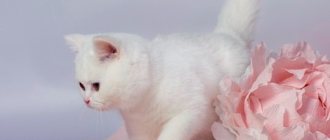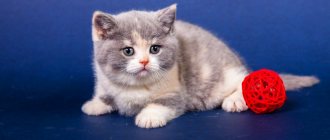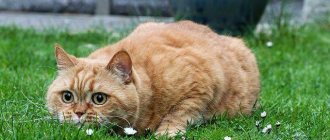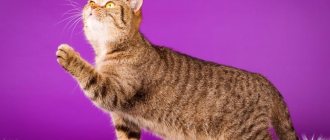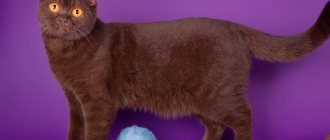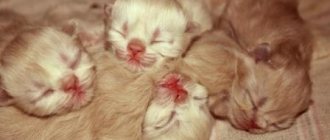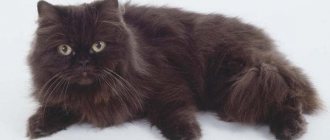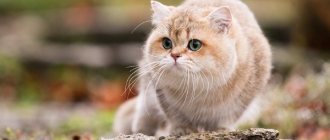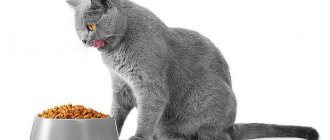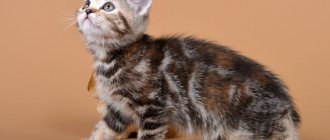British cats are famous for their variety of different coat and iris colors. Breeding representatives of the breed with different numbers of snow-white spots on their coats has become popular: bicolor cat, van, harlequin, tricolor. The main color of an animal's fur coat can be very different (black, chocolate, lilac, blue, etc.), and combinations of spots of various shapes are amazing.
BRITISH CATS WITH WHITE: TYPES OF COLOR
British cats with white in the color coding are supplemented by the number 01 - van, 02 - harlequin, 03 - bicolor - this is the relationship between the white color in the color and its quantity. There are the following types of colors with white spotting:
- bicolor/van/harlequin classic;
- tortoiseshell tricolors (calico);
- bicolor/van/harlequin/tricolor tabby;
- bicolor/van/harlequin/smoky tricolors;
- bicolor/van/harlequin/tricolor color-point;
- mixed colors (bicolor tortoiseshell shaded, bicolor color-point veiled, etc.).
The eye color of the British in color with white is always golden (yellow).
PHOTO GALLERY WITH DIFFERENT COLOR OPTIONS WITH WHITE
Photo: British cat black and white - black harlequin (black harlequin) BRI n 02 | British chocolate bicolor BRI b 03 | British kitten blue bicolor BRI a 03 |
| Photo: British cat cinnamon bicolor BRI o 03 |
|
| Photo: British red harlequin BRI d 02 |
| Photo: British black and white – British kitten black van BRI n 01 |
Photo: British black silver tabby bicolor Bri ns 22 03 |
| British tricolor cat - black and red tortoiseshell harlequin with white BRI f 02 |
| Photo: British cat lilac harlequin BRI d 02 | Photo: British cat blue van BRI a 01 | Photo: chocolate smoky bicolor BRI bs 03 |
| Photo: British kitten black and red tortoiseshell marbled bicolor BRI f 22 03 | Photo: British chocolate smoky color-point bicolor BRI bs 04 33 | Photo: British cinnamon color-point bicolor BRI o 04 33 |
COLOR OF BRITISH CAT BICOLOR (color code 03)
A British bicolor cat should be covered in white from 1/3 to 1/2 of the animal's color. The white color should be present from the British head in the form of a regular triangle, which begins on the forehead and diverges in both directions, touching the inner corners of the eyes. The collar and chest, the inside of the paws, and the belly should be white. The main color must be present on the head and back. The tail must be colored. There should be no white hairs in the main color (black, blue, lilac, etc.) - in this case, the color is rejected. The main color and white color must be clearly distinguished. The white spots are quite large, evenly distributed throughout the body. And, what is important, the overall color should look quite harmonious.
It must be said that sometimes bicolor British dogs do not always maintain an even white triangle on the head. Some white shift is allowed, but with clear boundaries. At least one ear must be painted in the main color.
Blue color with white British cats. Blue bicolor British
COLOR OF BRITISH CAT HARLEQUIN (color code 02)
The British Harlequin is also evenly distributed in color. The white color of the Harlequin British cat fills the color of approximately 5/6 of the coat color, the rest is colored color. The colored part of the color is present on the head, front legs, back, and tail.
Head: at least one colored spot, at least one ear of the animal must be colored.
Forelegs: Not desirable, but may have a few small spots of color. Ideally, the paws should be white.
Back: There may be colored spots with clear boundaries, not too small.
Tail: Fully colored.
The neck, collar, chest and paws are white.
COLOR OF BRITISH CAT VAN (color code 01)
The color of the British has the maximum amount of white, there are only a few colored spots: on the head (ideally two). The tail is completely colored. The ears should remain white. It is not desirable on the back, but a few spots of colored color are allowed. And, like all cats of this color category, there must be clear boundaries. There should be no white hairs in the colored form.
Blue tortoiseshell and white British cats. Blue-cream bicolor (calico, tricolor) British
COLOR OF BRITISH CAT MITTED (color code 04)
The mitted color in British cats is considered a disadvantage and is not recognized as a standard. There is too little white color, usually up to 1/4 of the part, it stretches from the head, passes through the neck, collar, chest and colors the stomach. The paws, as a rule, are also white, like the “socks”.
COLOR OF THE BRITISH CAT TRICOLORE (various combinations 04/03/02/01)
The British tricolor cat is also called calico or tortoiseshell and white. In addition to white, there are two more colors in the color. Spots of different colors do not intersect or mix, but have clear boundaries. Thus, the color retains the shape of the mosaic in a three-color version. The color, like all tortoiseshells, can only be found in cats.
Lilac-cream tortoiseshell and white British cats. Blue bicolor British
Smoky (smoky, tuxedo)
The color of Scottish Fold cats can be smoky. On top the coat is one color, for example black. And at the base, each hair is silvery-white. This coloring is characteristic of cats with a dominant silver gene, which creates unusual combinations of light and dark shades.
Smoky color is easy to confuse with solid color. To avoid mistakes, you just need to look at the undercoat. With a smoky color, the undercoat of a different shade is clearly visible, and with a solid color, the color of the roots does not differ from the tips.
The eyes of smoke cats are usually yellow-gold in color. Based on the shades of smoke on the fur, several subspecies of this color of animal are distinguished.
Blue smoke
Smoky blue Scottish Straights and Scottish Folds are distinguished by the color of their fur coat with a gray cold coating. But underneath the fur is white and silvery. The paw pads and nose of these pets are gray-blue.
Black smoke
This color in Scottish cats is characterized by a black edge, but the hair at the roots is white. The nose mirror and pads do not differ from the main background.
Chocolate smoke
The snow-white undercoat is combined with a brown-chocolate topcoat. The nose button and paw pads of these animals are brown in color.
Smoky Scottish Straights and Scottish Folds, despite their unique color, cannot participate in exhibitions. Such cats are not recognized by the breed standard.
BRITISH KITTENS BICOLOR, VAN, HARLEQUIN, TRICOLOR: GENETICS
British kittens with white (bicolor, van, harlequin, tricolor) can only be born to parents of this color (or at least from one of the parents). This color is dominant. If the parents are not carriers of this group, they will never give birth to a bicolor, van, harlequin, or tricolor kitten.
Important! For those who are engaged in breeding these spectacular elegant colors, it is important to understand that it is very desirable that both parents be white, because a kitten may be born mitted (not white enough), and this is rejected by breed standards.
British bicolor, van, harlequin, tricolor kittens are born with colored spots, over time the color becomes more saturated, and the edges of the other color even out and become clearer.
The S gene is responsible for this color .
Formula:
SS - dominant color with white. Producers with this formula will always produce only white kittens, regardless of the color of the second parent
Ss - color with white, carrier of a solid color. A pair of Ss+Ss can produce kittens with or without white.
ss - color without white. A pair of ss+ss can never produce a white kitten.
Tabby colors
Scottish tabby cats are very popular among breed lovers. This color suggests the presence of patterns on the pet’s fur.
Depending on their shape and size, tabbies are divided into three types:
- Striped (tiger) color - the presence of clearly defined vertical stripes.
- Spotted (leopard) - the pattern is made up of spots on the animal's fur.
- Marble color is a pattern of larger chaotic marks of different shapes.
- cream;
- golden;
- blue;
- marble on silver;
- black marble;
- silver;
- silver-blue.
A prerequisite for tabby cats is the presence of the letter “M” on the top of the animal’s forehead. The color combinations of wool are surprising in their diversity:
Important: Scottish tabbies with a silver tabby color resemble the mustachioed pet from a cat food commercial. Many believe that it is the Scottish straight-eared cat with a tabby pattern that appears on the screen. This color is also called the whiskey color of Scottish cats.
GALLERY OF PHOTOS OF BRITISH CATS, CATS, KITTENS OF COLOR BI-COLOR, HARLEQUIN, VAN, TRI-COLOR
Lilac color with white British cats. Lilac bicolor British
Red (fawn) color with white British cats. Red (fawn) bicolor British
| In our cattery you can “buy a real British kitten.” We have many different colors, we will help you choose and answer all your questions! |
Myths and reality of cat colors
The diversity and variability of cat colors has been laid down by nature itself since ancient times . After all, the wild ancestors of our cute purrs had to survive by adapting to a variety of environmental conditions - where those with spotted or striped “camouflage” had the best chances. But the real color potential of cats began to gradually reveal itself when they entered the service of humans.
Color, as it turned out, matters
At first, people were much more interested in the behavioral qualities of the cat - its hunting skills; the selection went in this direction. But the prerequisites for the emergence and consolidation of new colors have become much greater. In many countries, cats were endowed with mystical properties and even deified, so the birth of kittens of an unusual color attracted attention - many very old signs, beliefs and superstitions are associated with cats of a certain color: black, white, red...
Famous British palette
The British breed is good in many respects, but is especially famous for the variety of its colors. The standards of felinological organizations recognize that the British have more than 250 color variations of their fur coats, which can be short, long, fluffy, inherited from the Persians.
A variety of British colors can be represented even in one litter
It was the Persians who gave British cats a motley palette of colors. British women had a much poorer color “assortment” until Persian blood began to flow into the breed - it is believed that the lilac shades were obtained precisely from oriental cats. Such “inbreeding” with Persian, Carthusian and outbred cats was necessary to preserve and develop the breed during difficult periods for it.
Chinchilla
The Scottish chinchilla borrowed the extravagant colors of its coat from the British, and they, in turn, from Persian cats. A chinchilla kitten is born only from parents with an unusual color. Each hair is colored in two colors.
Most of it is light in color and 1/8 of it (the top) is dark in color. This phenomenon is called tipping.
Tipped chinchilla colors can be of 3 types:
